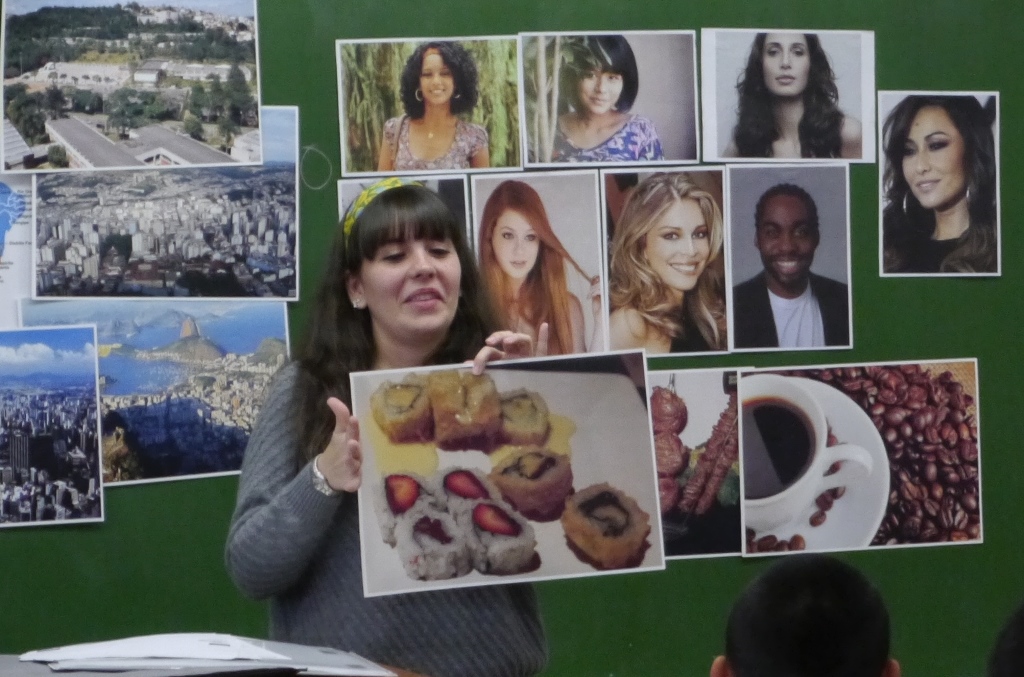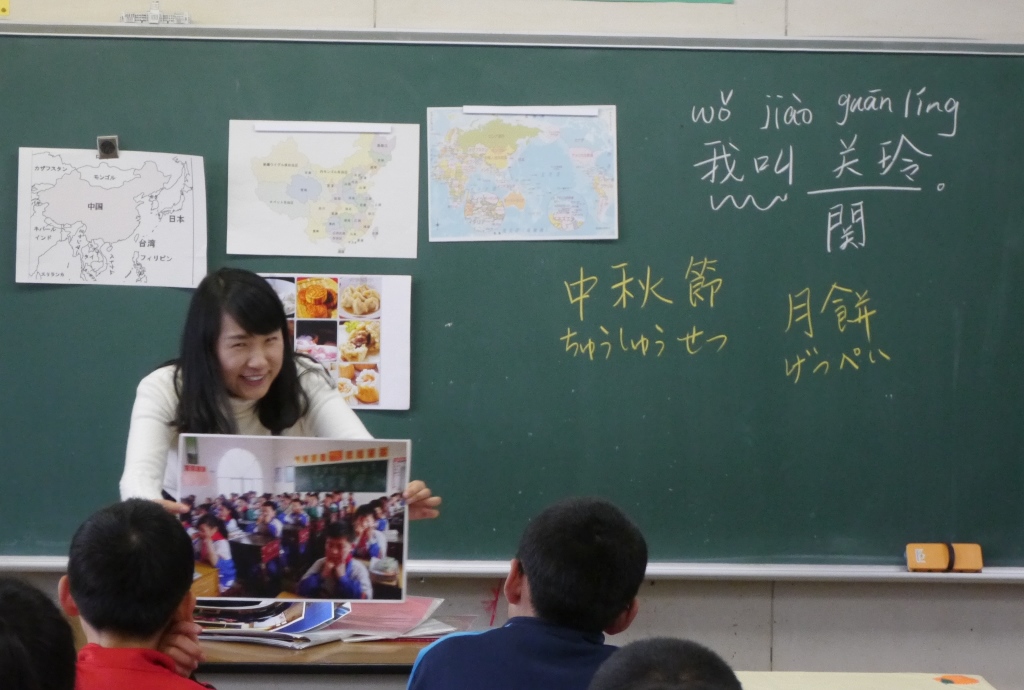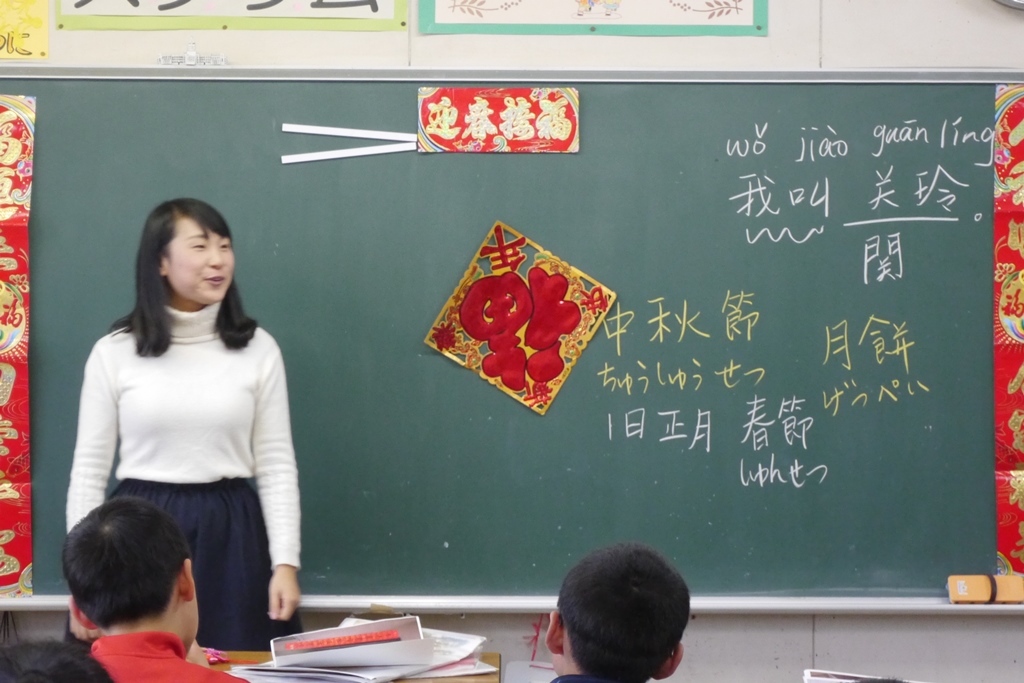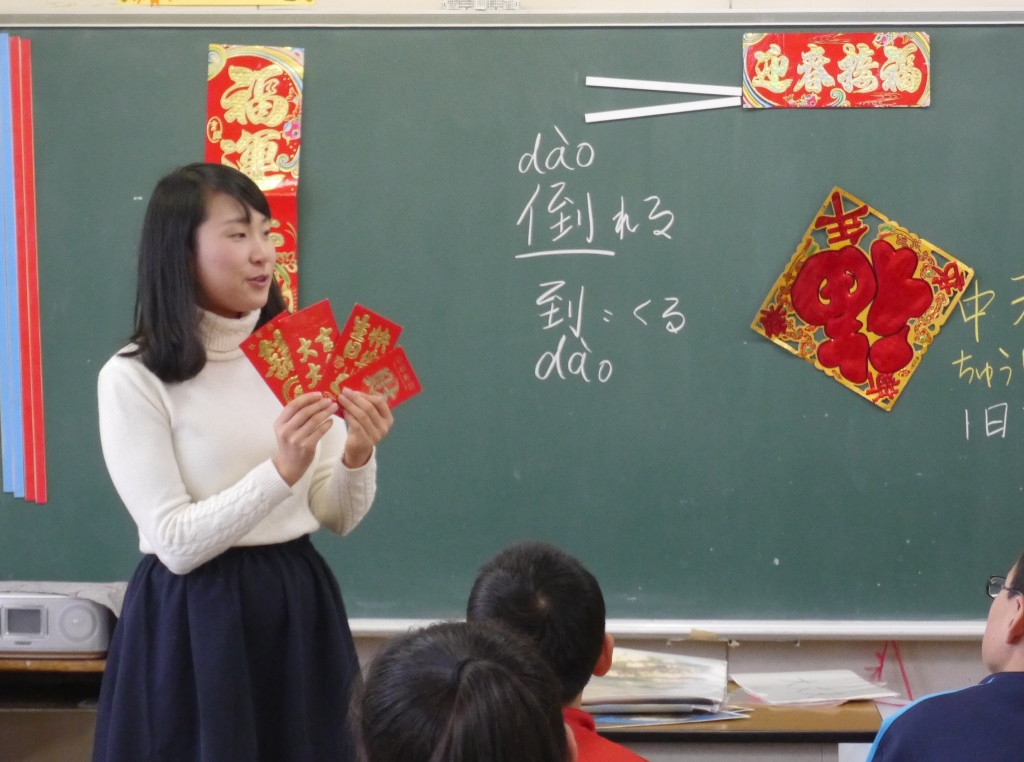
Date: February 9 (Thu), 2017 1:50 p.m.-3:25 p.m.
Venue: 6 grades at Namiki elementary school
Three foreign students: Ms. Guan Ling (Chinese), Ms. Collen Christina Scmuckal (American), Ms. Favero Souza Thais (Brazilian)
Assistant: Mr. Kazuo Horiuchi from Association for Promotion of International Understanding (APIU) Three AIRA supporters: Mr. and Mrs.Sekiguchi, Mr. Yabe
Abiko city has provided classes of the education program “Guest teachers are foreign students!” since 1994. In this program, foreign students are sent to schools as guest teachers. This program is run by a public interest foundation Multicultural Understanding Support Association to support multicultural understanding. Until last fiscal year, this program was conducted at schools including junior high schools, but in this fiscal year 2016, it is held at 13 elementary schools during last September to this February. (One program was suspended.)
Each foreign student gave 45 minute-class twice. Elementary students chose two among the 3 teachers’ classes. In the class, the quest teachers introduced themselves in their mother tongue and Japanese and talked about their hometown, their culture and lifestyle comparing them with Japanese ones and using pictures.
The followings are details of each class.
1. Ms. Collen Christina Schmuckal from U.S.A
Collen goes to Tokyo Art University postgraduate course. She is from Chicago and loves Sushi, rice balls, and curry and rice. As soon as the class began, she requested claps to take rhythm, and played the shamisen covered with dog’s skin in rhythm with claps.
Then she introduced herself and the town of Chicago. She explained showing a map that there is a big Lake Michigan in Chicago. When she was young, she had no idea of the sea. So she was surprised at salty sea water when she visited the beach for the first time. She talked that there are a lot of immigrants not only in Chicago but in all over U.S.A. She also talked about the origin of her name.
2. Ms. Favero Souza Thais from Brazil
Ms. Thais is a foreign student in law school of Waseda University and from Juiz de Fora in Minas Gerais state ( next to Rio de Janeiro state).
Brazil consists of immigrants. Many people immigrated from Africa, Europe, Asia and North America. She has two surnames (Favero and Souza). There are people who have as many as 4 surnames. As it takes time to write and call her name, she usually uses her first name, Thais
a. Culture: They hug and kiss when they great each other. She advised the students they should be ready for this custom.
b. Introduction of some cities: old capital Rio de Janeiro, new capital Brasilia which is built in the inner land, San Paulo where a lot of buildings are located, and her native city, Juiz de Fora which is a vast land with no famous landmarks other than university. She introduced Brazilian cities showing various photos.
c. She gave a quiz “Who is Brazilian?” showing pictures of entertainers. All the people she showed were Brazilians from Europe, Africa and Asia. She also explained that Brazil consists of immigrants and slaves. There are many Japanese-Brazilians and they generally understand Japanese.
d. If restaurants offer all-you-can-eat buffet, there is no time limit. They enjoy meals leisurely talking each other. She was surprised at the time-limit system in Japanese restaurants.
e. Food: They eat fruit Sushi (sushi with cream, chocolate, and fruit such as strawberry ) as dessert. They like sweets.
f. Why she came all the way to Japan from the opposite side of the earth ?: When she was a high school student, she liked Japanese animation. She visited Japan and she came to love Japanese culture. After she went back to Brazil, she challenged a very difficult exam for scholarship. She didn’t give up and finally she passed it and came to Japan again. She wanted to tell the message “Never give up for your dream.”
g. Lots of questions from the students to her about her favorites went on.
3. Ms. Guan Ling from China
She is a foreign student at Tsukuba University postgraduate course. She is from Shaoyang, Hunan, China. She explained how to pronounce Chinese characters. “Like it!” is “Zan” in Chinese. The students memorized it easily and said the word positively.
a. The date of Chun Jie (New Year in China) is different every year because they use the lunar calendar. Her birthday is 26th of Jun in the lunar calendar. But in the solar calendar, it differs every year.
b. Chun Jie lasts 15 days. They paste ornaments on the entrance door for happiness. They have customs of new- year money gift (otoshidama), money gift for birthday and marriage comparing with Japanese customs.
c. School life: They buy lunch at cafeteria at school. Lunch time is 2 and half hours long including nap time. Since there is no nap time at school in Japan, it took time for her to get used to this Japanese life style.
d. They played stone-paper-scissors in Chinese (shi tou-Jian dao-bu). Winners got a fish-shaped small thing.
e. Questions from the students
(1) What surprised her? : Japanese people eat raw vegetable, tofu and meat whereas Chinese people fry them.
(2) World heritage in China: Great Wall ; Chinese should climb up the wall. They say “If you don’t climb up the Great Wall, you are not called a fine man.”
(3) Common aspects with Japan: They eat rice. They eat nikuman, meat dumpling, as breakfast.
(4) Different aspects: In Japan, they eat fish on an individual plate. But in China, they eat fish on a big plate at the round table and share it with people. In dinner menu, there is fish dish. Fish is pronounced “yu” in Chinese which is the same pronunciation as abundance of money. That’s why fish is indispensable
The three foreign students were all cheerful and friendly.
After the classes finished at a waiting room, the snow changed to sleet. Collen from Chicago said “It’s not cold.” In Chicago, it snows a lot. But it’s not cold when it snows. When the humidity is low, and there’s no water to become snow, it’s really chilly, she said. And she used shamisen covered with dog’s skin instead of cat’s skin because the sound was different and she preferred the sound of shamisen with dog’s skin to that with cat’s skin.
AIRA volunteer stuff also attended the classes. They listened to the lecture and even after the classes, they listened to the teachers’ talk. In addition, as all the foreign students spoke Japanese fluently, I felt as if I had attended the mini cross-cultural understanding course of AIRA. It was a good opportunity to deepen my understanding of foreign affairs.
The railway station where AIRA stuff picked them up was near from the school. Foreign students who joined this program for the first time seemed to have no worries, since they were accompanied by an assistant from APIU. The assistant deeply thanked AIRA volunteer stuff for their assistance.
(No.16-32 Translated by Rie Hama)








